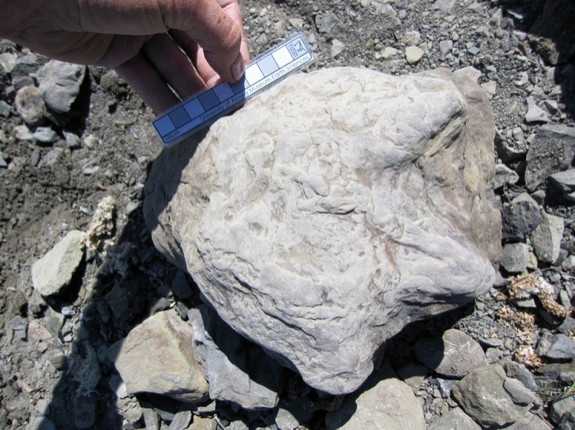Thousands Of Dinosaur Footprints Found By Alaksa's Yukon River

Paleontologists have discovered thousands of dinosaur footprints dating back 30 million years alongside Alaska’s Yukon River.
In July, scientists from the University of Alaska Museum of the North discovered the dinosaur footprints while on a 500-mile trek alongside the Tanana and Yukon Rivers. After their expedition, the researchers were able to bring back more than 2,000 pounds of dinosaur footprint fossils. Scientists with the exposition said the number of fossils they found was breathtaking.
"We found dinosaur footprints by the scores on literally every outcrop we stopped at," Paul McCarthy, of the University of Alaska Fairbanks, said in a statement. "I've seen dinosaur footprints in Alaska now in rocks from southwest Alaska, the North Slope and Denali National Park in the Interior, but there aren't many places where footprints occur in such abundance."
"The tracks were so abundant along the Yukon River that we could find and collect as many as 50 specimens in as little as 10 minutes,” he added.
Researchers at the University of Alaska believe the footprints date back some 25 to 30 million years. Unusually, however, many of the fossils discovered along the Yukon were raised off of the rocks, rather than imprinted into them. Mark Norell, head of paleontology at the American Museum of Natural History in New York, explained to ABC that the process of creating such fossils is not unlike what happens to footprints when walking on wet sand.
"If there's a big storm and the footprint is covered in clay blown from the hillside, it will cover the footprint," he told ABC News. Over time, the clay hardens and creates a mold of what the dinosaur’s foot looked like. "It's like you're seeing the animal's foot while it was alive."
This is not the first major fossil find in Alaska. In 2005, researchers discovered similar dinosaur footprints in Denali National Park. Many of those footprints were considerably older, formed roughly 65 million to 80 million years ago in the late Cretaceous period. These days, such finds are rate, but because Alaska is so large and relatively unexplored by paleontologists, there’s plenty of room to make large discoveries such as these.
“This is the kind of discovery you would have expected in the Lower 48 a hundred years ago," Pat Druckenmiller, the earth sciences curator at the University of Alaska Museum of the North, said in a statement. "We found a great diversity of dinosaur types, evidence of an extinct ecosystem we never knew existed."
© Copyright IBTimes 2024. All rights reserved.






















